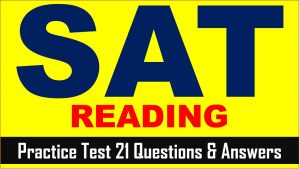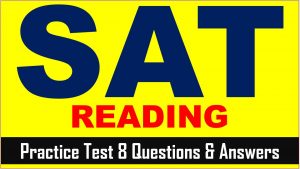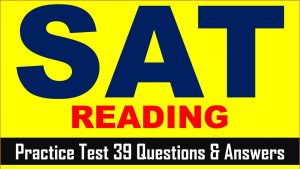Hi SAT Aspirants, welcome to AKVTutorials. As you know SAT (Scholastic Assessment Test) is a standard test, used for taking admission to undergraduate programs of universities or colleges of United States. SAT is developed and published by the College Board, an organization in United States, administered by the Educational Testing Service. Are you searching for SAT Reading Practice Questions? Then, in this article of AKVTutorials, you will get SAT Reading Section Practice Test 73 | SAT 2024 Online Tutor AMBiPi
SAT Reading Practice Passage
SAT Reading Practice Test Comprehensive Passage
This passage is adapted from a novel first published in the literary magazine the New writing in autumn of 1936. The following 13 multiple choice questions are based on this passage below.
| One day something happened which in a roundabout way | |
| was enlightening. It was a tiny incident in itself, but it gave me a | |
| better glimpse than I had had before of the real nature of Line | |
| imperialism-the real motives for which despotic | |
| Line 5 | governments act. Early one morning the sub-inspector at a |
| police station the other end of the town rang me up on the | |
| phone and said that an elephant was ravaging the bazaar. | |
| Would I please come and do something about it? I did not | |
| know what I could do, but I wanted to see what was | |
| Line 10 | happening and I got on to a pony and started out. I took my |
| rifle, an old .44 Winchester and much too small to kill an | |
| elephant, but I thought the noise might be useful in terrorem. | |
| Various Burmans stopped me on the way and told me about | |
| the elephant’s doings. It was not, of course, a wild elephant, but | |
| Line 15 | a tame one which had gone “must.” It had been chained up, as |
| tame elephants always are when their attack of “must” is | |
| due, but on the previous night it had broken its chain and | |
| escaped. Its mahout, the only person who could manage it | |
| when it was in that state, had set out in pursuit, but had taken | |
| Line 20 | the wrong direction and was now twelve hours’ journey away, |
| and in the morning the elephant had suddenly reappeared in | |
| the town. The Burmese population had no weapons and were | |
| quite helpless against it. It had already destroyed somebody’s | |
| bamboo hut, killed a cow, and raided some fruit-stalls and | |
| Line 25 | devoured the stock; also it had met the municipal rubbish van |
| and, when the driver jumped out and took to his heels, had | |
| turned the van over and inflicted violence’s upon it. | |
| The Burmese sub-inspector and some Indian constables were | |
| waiting for me in the quarter where the elephant had been | |
| Line 30 | seen. It was a very poor quarter, a labyrinth of squalid |
| bamboo huts, thatched with palm-leaf, winding all over a | |
| steep hillside. I remember that it was a cloudy, stuffy | |
| morning at the beginning of the rains. We began questioning | |
| people as to where the elephant had gone, and, as usual, | |
| Line 35 | failed to get any definite information. That is invariably the |
| case in the East; a story always sounds clear enough at a | |
| distance, but the nearer you get to the scene of events the | |
| vaguer it becomes. Some of the people said that the elephant | |
| had gone in one direction, some said that he had gone in | |
| Line 40 | another, some professed not even to have heard of an |
| elephant. I had almost made up my mind that the whole story | |
| was a pack of lies, when we heard yells a little distance away. | |
| There was a loud, scandalized cry of “Go away, child! Go | |
| away this instant!” and an old woman with a switch in her | |
| Line 45 | hand came round the corner of a hut, violently shooing away |
| a crowd of naked children. Some more women followed, | |
| clicking their tongues and exclaiming; evidently there was | |
| something that the children ought not to have seen. I rounded | |
| the hut and saw a man’s dead body sprawling in the mud. He | |
| Line 50 | was an Indian, a black Dravidian coolie, almost naked, and he |
| could not have been dead many minutes. The people said that | |
| the elephant had come suddenly upon him round the corner | |
| of the hut, caught him with its trunk, put its foot on his back, | |
| and ground him into the earth. This was the rainy season and | |
| Line 55 | the ground was soft, and his face had scored a trench a foot |
| deep and a couple of yards long. He was lying on his belly | |
| with arms crucified and head sharply twisted to one side. His | |
| face was coated with mud, the eyes wide open, the teeth | |
| bared and grinning with an expression of unendurable agony. | |
| Line 60 | (Never tell me, by the way, that the dead look peaceful. Most |
| of the corpses I have seen looked devilish.) The friction of the | |
| great beast’s foot had stripped the skin from his back as | |
| neatly as one skins a rabbit. | |
| As soon as I saw the dead man I sent an orderly to a friend’s | |
| Line 65 | house ‘nearby to borrow an elephant rifle. I had already sent |
| back the pony, not wanting it to go mad with fright and throw | |
| me if it smelled the elephant. |
SAT Reading Comprehension Practice Test Questions
SAT Reading Practice Test Question No 1
Which choice best describes the general theme of the passage?
Option A : An account of a series of events leading to a disaster.
Option B : An example put forward and analyzed in details.
Option C : A description of the aftermath of a horrible incident.
Option D : A reiteration of recent accounts passed on through people.
SAT Practice Test Answer No 1
Show/Hide Answer
Option C : A description of the aftermath of a horrible incident.
SAT Reading Practice Test Question No 2
It can be reasonably inferred from the passage that the character “I” is
Option A : a colonial policeman.
Option B : a detective of station.
Option C : a judge of village court.
Option D : a chief inspector.
SAT Practice Test Answer No 2
Show/Hide Answer
Option A : a colonial policeman.
SAT Reading Practice Test Question No 3
Based on the information of the passage, what can be inferred from the roundabout way” in line 1?
Option A : Deep down inside, I consider myself to be an imperialist by nature and after years of training.
Option B : Imperialistic actions should have manifested itself in a more significant event than this.
Option C : The motives for government atrocities can never be underestimated with certainty.
Option D : None of the previous incidents indicates whatsoever about the real intent of the colonial Agency.
SAT Practice Test Answer No 3
Show/Hide Answer
Option B : Imperialistic actions should have manifested itself in a more significant event than this.
SAT Reading Practice Test Question No 4
As indicated in line15, the word “must” means
Option A : mischievousness.
Option B : berserk.
Option C : crudeness.
Option D : agonies.
SAT Practice Test Answer No 4
Show/Hide Answer
Option B : berserk.
SAT Reading Practice Test Question No 5
The author suggests that the “mahout” in line 18 is probably someone
Option A : who can communicate with the elephant intimately.
Option B : who has also worked in the village as the constable.
Option C : who has in-depth knowledge of tracking the elephant.
Option D : who owns and reins the elephant in its daily life.
SAT Practice Test Answer No 5
Show/Hide Answer
Option D : who owns and reins the elephant in its daily life.
SAT Reading Practice Test Question No 6
The list of incidents accounted by the author in lines 22-27 is mainly to
Option A : indicate the elephant behaves with random violences.
Option B : suggest the necessity of destroying such a willful animal.
Option C : recognize the urgency of advising the public to avoid it.
Option D : criticize on the viciousness of the escape animal.
SAT Practice Test Answer No 6
Show/Hide Answer
Option A : indicate the elephant behaves with random violences.
SAT Reading Practice Test Question No 7
Why couldn’t the lead character in the passage get any definite information about the elephant?
Option A : The villagers accounts are full of intentional lies.
Option B : The route of elephant escape is distorted by many.
Option C : The different versions of accounts add more confusion.
Option D : The physical distance affects the truthfulness of story.
SAT Practice Test Answer No 7
Show/Hide Answer
Option C : The different versions of accounts add more confusion.
SAT Reading Practice Test Question No 8
Which choice provides the best evidence for the answer to the previous question?
Option A : Lines 28-32 (“The…hillside”)
Option B : Lines 35-38 (“That…becomes”)
Option C : Lines 38-41 (“Some…elephant”)
Option D : Lines 41-46 (“I…children”)
SAT Practice Test Answer No 8
Show/Hide Answer
Option B : Lines 35-38 (“That…becomes”)
SAT Reading Practice Test Question No 9
The main purpose of the second paragraph in the whole passage is to
Option A : elaborate on one particular incident as counter evidence.
Option B : exemplify the horror of one particular group of people.
Option C : analyze the real evidences left on the scene of killing.
Option D : describe in detail an incident as grounds for later actions.
SAT Practice Test Answer No 9
Show/Hide Answer
Option D : describe in detail an incident as grounds for later actions.
SAT Reading Practice Test Question No 10
In line 55, the word “scored” most closely means
Option A : leveled at.
Option B : settled as.
Option C : resulted in.
Option D : recorded of.
SAT Practice Test Answer No 10
Show/Hide Answer
Option C : resulted in.
SAT Reading Practice Test Question No 11
The enclosed sentence in the parenthesis of lines 60-61 is best understood as
Option A : a careful reservation to previous judgement.
Option B : a qualification to a public-held misconception.
Option C : a preemptive response to probable response.
Option D : a speculative conclusion drawn on available facts.
SAT Practice Test Answer No 11
Show/Hide Answer
Option C : a preemptive response to probable response.
SAT Reading Practice Test Question No 12
What is the most widely employed rhetorical strategy in the passage?
Option A : Contrasting between the character’s composure and terrified responses of victims or spectators.
Option B : Using analogy in describing the elephant as an intelligent being throughout the passage.
Option C : Using the third party perspectives to account for the thoughts and struggles of character.
Option D : Indicating the irony of the character’s inability by depicting him as a very capable figure.
SAT Practice Test Answer No 12
Show/Hide Answer
Option A : Contrasting between the character’s composure and terrified responses of victims or spectators.
SAT Reading Practice Test Question No 13
Viewed in its entirety, the passage suggests that the character “T” changed his plan for the elephant
Option A : from shooting it to containing it
Option B : from imprisoning it to catching it.
Option C : from scaring away to killing it.
Option D : from containing it to setting it free.
SAT Practice Test Answer No 13
Show/Hide Answer
Option C : from scaring away to killing it.



